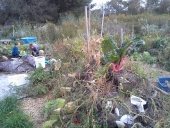




Project EcoGrid is a 501c3 nonprofit organization in Detroit and Cincinnati. We are dedicated to sustainable human habitation and transportation. ProjectEcoGrid.com
 1
1








Project EcoGrid is a 501c3 nonprofit organization in Detroit and Cincinnati. We are dedicated to sustainable human habitation and transportation. ProjectEcoGrid.com









A human being should be able to change a diaper, plan an invasion, butcher a hog, conn a ship, design a building, write a sonnet, balance accounts, build a wall, set a bone, comfort the dying, take orders, give orders, cooperate, act alone, solve equations, analyze a new problem, pitch manure, program a computer, cook a tasty meal, fight efficiently, die gallantly. Specialization is for insects.
-Robert A. Heinlein








A human being should be able to change a diaper, plan an invasion, butcher a hog, conn a ship, design a building, write a sonnet, balance accounts, build a wall, set a bone, comfort the dying, take orders, give orders, cooperate, act alone, solve equations, analyze a new problem, pitch manure, program a computer, cook a tasty meal, fight efficiently, die gallantly. Specialization is for insects.
-Robert A. Heinlein









A human being should be able to change a diaper, plan an invasion, butcher a hog, conn a ship, design a building, write a sonnet, balance accounts, build a wall, set a bone, comfort the dying, take orders, give orders, cooperate, act alone, solve equations, analyze a new problem, pitch manure, program a computer, cook a tasty meal, fight efficiently, die gallantly. Specialization is for insects.
-Robert A. Heinlein








A human being should be able to change a diaper, plan an invasion, butcher a hog, conn a ship, design a building, write a sonnet, balance accounts, build a wall, set a bone, comfort the dying, take orders, give orders, cooperate, act alone, solve equations, analyze a new problem, pitch manure, program a computer, cook a tasty meal, fight efficiently, die gallantly. Specialization is for insects.
-Robert A. Heinlein








A human being should be able to change a diaper, plan an invasion, butcher a hog, conn a ship, design a building, write a sonnet, balance accounts, build a wall, set a bone, comfort the dying, take orders, give orders, cooperate, act alone, solve equations, analyze a new problem, pitch manure, program a computer, cook a tasty meal, fight efficiently, die gallantly. Specialization is for insects.
-Robert A. Heinlein





 1
1




Kevin Sanders wrote:I know its good for a fertilizer but what else could I use it for?
Always open to a barter. Whatcha got?
 4
4























Country oriented nerd with primary interests in alternate energy in particular solar. Dabble in gardening, trees, cob, soil building and a host of others.




No, not exactly. They make two different kinds of pellets. The one they eat after their food goes through the first time is soft and green - like a goat's cud, not like poop. Their poo pellets are just poo and they do not re-eat them. I find it to be pretty equivalent to goat poo as far as the effect it has on my plants, no better, no worse.rabbits are not efficient at deriving nourishment from what they eat; they often eat their own poo at least one time through for that reason. I think that rabbit poo is likely, for that reason, to contain a lot of broken down but unabsorbed nutrients that are superior plant food.




Al Senner wrote:a word of warning. i got enough rabbit waste from a neighbor to cover my garden about 2in during the winter. spring came and i planted and my plants were burned.
-Manda
I am not at all related to Paul Wheaton, the amazingness of this great forum! We just share a great name! Currently here working through life, as a middle age widow, who balances work, school, chlidren while trying to build her empire of a beautiful permaculture friendly homestead in Michigan in my "spare" time.
 1
1

















|
This is awkward. I've grown a second evil head. I'm going to need a machete and a tiny ad ...
100th Issue of Permaculture Magazine - now FREE for a while
https://permies.com/goodies/45/pmag
|









